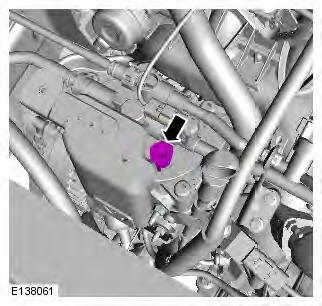Range Rover Evoque: Fuel System - General Information
Capacities

Fuel System Pressure Release GTDi 2.0L Petrol
Draining
1. Refer to: Petrol and Petrol-Ethanol Fuel Systems Health and Safety Precautions (100-00 General Information, Description and Operation).
2. Remove the fuel pump fuse.
3. Remove the fuel filler cap.
4. Start the engine and allow it to idle until the engine stalls.
5. Crank the engine for approximately five seconds to make sure that the fuel rail pressure is released.
Filling
1. NOTE: Make sure all repairs have been carried out before proceeding to the following steps. Install the fuel pump fuse.
2. Install the fuel filler cap.
3. Crank the engine until it starts.
4. Read and clear stored DTC fault codes.
Diesel Filter Water Drain-Off
WARNINGS:
Avoid flames, sparks or lighted substances.
Wait for a minimum of 1 minute after the engine has stopped before carrying out any repair to the fuel injection system.
CAUTION: Make sure that the area around the component is clean and free of foreign material.
1. Refer to: Engine Cover - TD4 2.2L Diesel (501-05 Interior Trim and Ornamentation, Removal and Installation).
2. WARNING: Make sure to support the vehicle with axle stands. Raise and support the vehicle.
3. Refer to: Engine Undershield (501-02 Front End Body Panels, Removal and Installation).
4. Position a container to collect the fluid.

5. CAUTION: Make sure that all fluid is drained from the fuel filter.

Filling
WARNINGS: Avoid flames, sparks or lighted substances.
Wait for a minimum of 1 minute after the engine has stopped before carrying out any repair to the fuel injection system.
CAUTION: Make sure that the area around the component is clean and free of foreign material.
1.

2. Remove the container.
3. Refer to: Engine Undershield (501-02 Front End Body Panels, Removal and Installation).
4. Refer to: Engine Cover - TD4 2.2L Diesel (501-05 Interior Trim and Ornamentation, Removal and Installation).
5. Refer to: Fuel System Bleeding - TD4 2.2L Diesel (310-00 Fuel System - General Information, General Procedures).
Fuel Tank Draining
WARNINGS: Place the vehicle in a well ventilated.
Do not carry or operate cellular phones when working on or near any fuel related components. Highly flammable vapors are always present and may ignite. Failure to follow these instructions may result in personal injury.
Do not smoke or carry lighted tobacco or open flame of any type when working on or near any fuel related components. Highly flammable vapors are always present and may ignite. Failure to follow these instructions may result in personal injury.
The spilling of fuel is unavoidable during this operation. Ensure that all necessary precautions are taken to prevent fire and explosion.
CAUTION: Before disconnecting or removing components, ensure the area around the joint faces and connections are clean. Plug open connections to prevent contamination.
NOTE: It is possible that up to 18 litres of fuel may be left in the tank after draining.
1. Open the fuel filler door and remove the cap.
2. Disconnect the battery ground cable.
Refer to: Specifications (414-01 Battery, Mounting and Cables, Specifications).
3. Connect the fuel tank drain equipment ground cable to the vehicle.
4. WARNING: Fuel may still be present in the fuel tank after draining.
Remove the fuel from the fuel tank, via the filler neck, using the fuel tank draining equipment. Follow the manufacturer's operating instructions.
5. To install, reverse the removal procedure.
Fuel System Bleeding TD4 2.2L Diesel
Special Tool(s)
 310-163
310-163
Bleeder, Fuel System
WARNINGS: Avoid flames, sparks or lighted substances.
Wait for a minimum of 1 minute after the engine has stopped before carrying out any repair to the fuel injection system.
CAUTION: Make sure that the area around the component is clean and free of foreign material.
1. This procedure is necessary if any of the following fuel system components are removed, disconnected or replaced: Fuel tank, low pressure fuel lines or the fuel filter.
2. Remove the engine cover.
Refer to: Engine Cover - 2.2L Diesel (501-05, Removal and Installation).
3. CAUTIONS: Extreme cleanliness must be exercised when handling these components.
Be prepared to collect escaping fuel.
Disconnect the fuel line.

4. CAUTION: Be prepared to collect escaping fuel.
NOTE: Make sure that the fuel flow direction arrow on the special tool is pointing towards the fuel filter.
- Install the special tool between the fuel supply line and the fuel filter.
- Special Tool(s): 310-163
Prime the fuel filter by squeezing the hand pump several times until the pump is hard.

5.
- Remove the special tools.
- Special Tool(s): 310-163
Connect the fuel lines.
6. Install the engine cover.
Refer to: Engine Cover - 2.2L Diesel (501-05, Removal and Installation).

